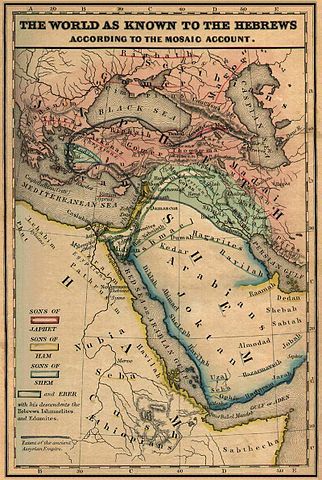
Ashkenaz is shown in Phrygia in this 1854 map of “The World as known to the Hebrews” (Lyman Coleman, Historical Textbook and Atlas of Biblical Geography) | (c) en.wikipedia.org/wiki/Ashkenaz
Ashkenazic Jews, a vibrant and influential Jewish community, emerged from humble beginnings in the 8th and 9th centuries. Their history takes us through a remarkable rise, a golden age, and a subsequent decline before finding new homes in Eastern Europe, Western Europe, and the Americas. Join us as we delve into the story of Ashkenazic Jewry, a small yet impactful population that has left an indelible mark on history.
Embark on a captivating journey through our shared history by joining us on a remarkable riverboat cruise with Kosher River Cruises. Immerse yourself in an exquisite travel experience, indulging in fine kosher dining and daily services. Discover breathtaking destinations while enjoying luxurious accommodations onboard. Join our Jewish tours and create memories that go beyond the ordinary.
The Name and Geographic Origins
To understand the roots of Ashkenazic Jews, we first explore the origin of their name. The term “Ashkenaz” traces back to biblical times, as one of the grandsons of Noah was named Ashkenaz. While the exact location of the biblical land of Ashkenaz remains uncertain, medieval Jewish thinkers associated it with a central region in Germany, known as the Rhineland. This geographical area would become the heartland of Ashkenazic Jewish civilization.
The Rise and Golden Age
From their earliest settlements in the Rhineland, Ashkenazic Jews began to develop a unique Jewish culture influenced by their Middle Eastern origins and European surroundings. They spoke Yiddish, a distinct Hebrew dialect, and established their own customs and traditions. During the “Golden Age of Ashkenaz” (11th-13th centuries), the Jewish community flourished economically, intellectually, and spiritually. Figures like Rashi, a renowned rabbi and scholar, made significant contributions to Jewish law and thought, shaping the development of Jewish identity during this era.
Challenges and Migration
The decline of Ashkenazic Jewry arrived in the 13th and 14th centuries due to various factors, including plagues and persecutions. As a result, many Ashkenazic Jews migrated primarily to the east, finding new homes in regions such as Poland, Lithuania, and Ukraine. Their population, while relatively small compared to the overall population, played a substantial role in these areas and continued contributing to science, medicine, literature, and other fields.
Emigration to Western Europe and the Americas
The 19th century marked another significant chapter for Ashkenazic Jews, as large numbers of them began immigrating to Western Europe and the Americas. This era coincided with the Age of Enlightenment, which brought positive changes and increased acceptance for Jews in European societies. Ashkenazic Jews moved out of ghettos, assimilated into local cultures, and became active participants in the economic and social fabric of their new homelands.
The Holocaust and its Aftermath
Unfortunately, the 20th century brought immense tragedy for Ashkenazic Jews. The Holocaust, perpetrated by the Nazi regime, resulted in the genocide of six million Jews, including a significant number of Ashkenazic Jews. This devastating event severely impacted the community, leading to widespread displacement and migration. Many survivors sought refuge in countries like the United States and contributed to the rich tapestry of Jewish life in their new homes.
Continued Contributions and Diversity
Today, Ashkenazic Jews remain a vibrant and diverse community, upholding their rich cultural heritage and making significant contributions worldwide. Their legacy encompasses achievements in various fields, including science, art, literature, and entrepreneurship. Ashkenazic Jews continue to shape the world around them, fostering a deep sense of identity and purpose.
The story of Ashkenazic Jews spans centuries, from their modest beginnings to their remarkable journey across continents. Despite facing challenges and persecution, they have left an indelible imprint on Jewish history and the wider world. Their unique culture, contributions, and resilience serve as a testament to the enduring strength of the Jewish people.
